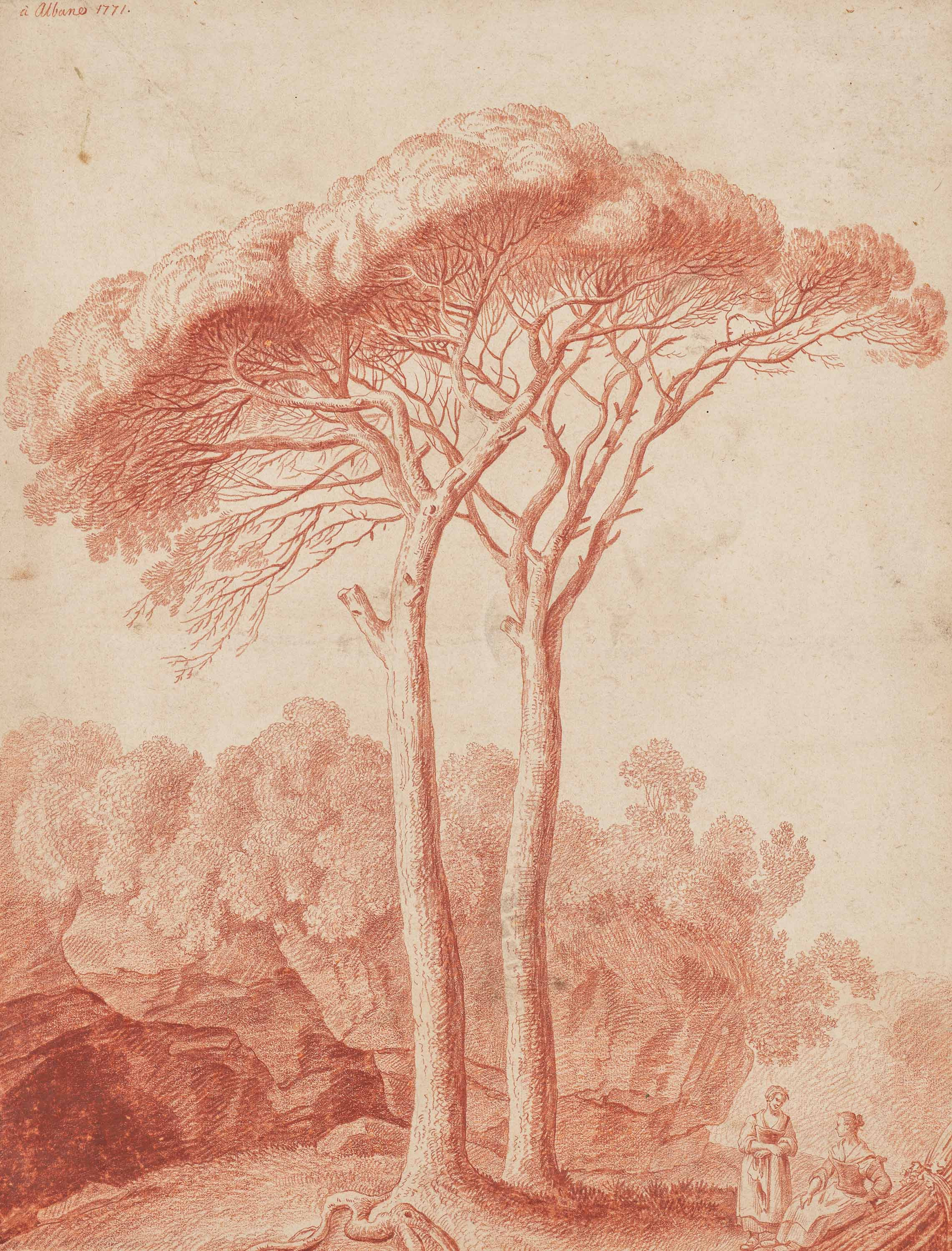HACKERT, JAKOB PHILIPP1737 Prenzlau - 1807 Florence
Title: Two Pine Trees Near Albano.
Date: 1771.
Technique: Red chalk on beige paper.
Measurement: 52 x 40cm.
Notation: Inscribed and dated upper left: "à Albano 1771".
Provenance:
Private ownership for three generations, Germany.
Certificate:
Claudia Nordhoff, Rome, 13.02.2024, copy available:
The landscape painter Jakob Philipp Hackert had received his first training in Berlin (1753-1762). After spending time in Stralsund and on the island of Rügen (1762-1765), he lived and worked in Paris for three years and then travelled to Italy in the summer of 1768. He arrived in Rome in December of the same year. Here Hackert quickly became the most famous landscape painter not only in the Eternal City, but in the whole of Europe. Immediately after his arrival, Hackert began to explore the surrounding landscape. In Rome, he had made the acquaintance of the Swedish sculptor Johan Tobias Sergel (1740-1814) and the French painter Antoine François Callet (1741-1823), with whom he undertook a hike in the Alban Hills south-east of Rome in the spring of 1769. During this first hike, Hackert, who was used to the northern vegetation, must have been fascinated not least by the southern tree species, which were unknown to him at the time. In fact, the artist had already begun to draw trees from nature in Berlin; in Italy, the "tree portrait" became his speciality. Botanical studies were indispensable for such a detailed investigation of trees, which Hackert pursued with almost scientific fervour. One of the trees that attracted Hackert's attention as early as 1769 was the maritime pine, currently recognised as the Italian national tree. This tree species, native to the northern Mediterranean region, grows up to 30 metres high and is 250 years old. Pine trees characterise the Roman cityscape, but they can be found throughout Lazio.
In the drawing now on offer (lot 1044), we see two tall trees whose crowns seem to merge into one above the slender trunks. Below them, two countrywomen are resting with a bundle of wood, which on the one hand can be interpreted as typical representatives of the local population and on the other hand provide a scale. The drawing was executed in red chalk. This reminds us that Hackert was still experimenting with various drawing techniques in the early Roman years. In later years, the artist would limit himself to pencil or pen, with which the contours of the landscape elements could be reproduced precisely, and then later rework them with a sepia brush. The warm red tones, on the other hand, allowed the artist to create a painterly rendition of the southern atmosphere, which is also characterised by the pine trees. In our drawing, the trees rise up into a cloudless sky against which the branches elaborate their filigree pattern; dark shadows lie beneath the sunlit bundles of needles, lending the treetops a spatial dimension. Under Hackert's pencil, the pines themselves seem to transform into a work of art - and the painter shows you nothing but the reality of the area near Albano. The drawing thus proves to be a high-quality work of art in its own right. At the same time, however, it is a valuable addition to the group of "tree portraits" executed in the Alban Hills in the 1770s, in which Hackert took an inventory, as it were, of the trees in the area. The wanderers or country folk who appear repeatedly in the sheets emphasise the principle of movement in the pictorial space and remind us that each drawing is only part of a larger whole. And so Hackert takes the viewer on a journey that leads into the depths to the two pine trees, which are presented in all their beauty. The path will lead the artist further, towards new views and new trees, which can be captured in ever new drawings. This transfer of landscape into art was Hackert's final goal.
We are grateful to Claudia Nordhoff, Rome, who confirmed the attribution of the present drawing on the basis of a high-resolution digital photograph, for her help in cataloguing it.

